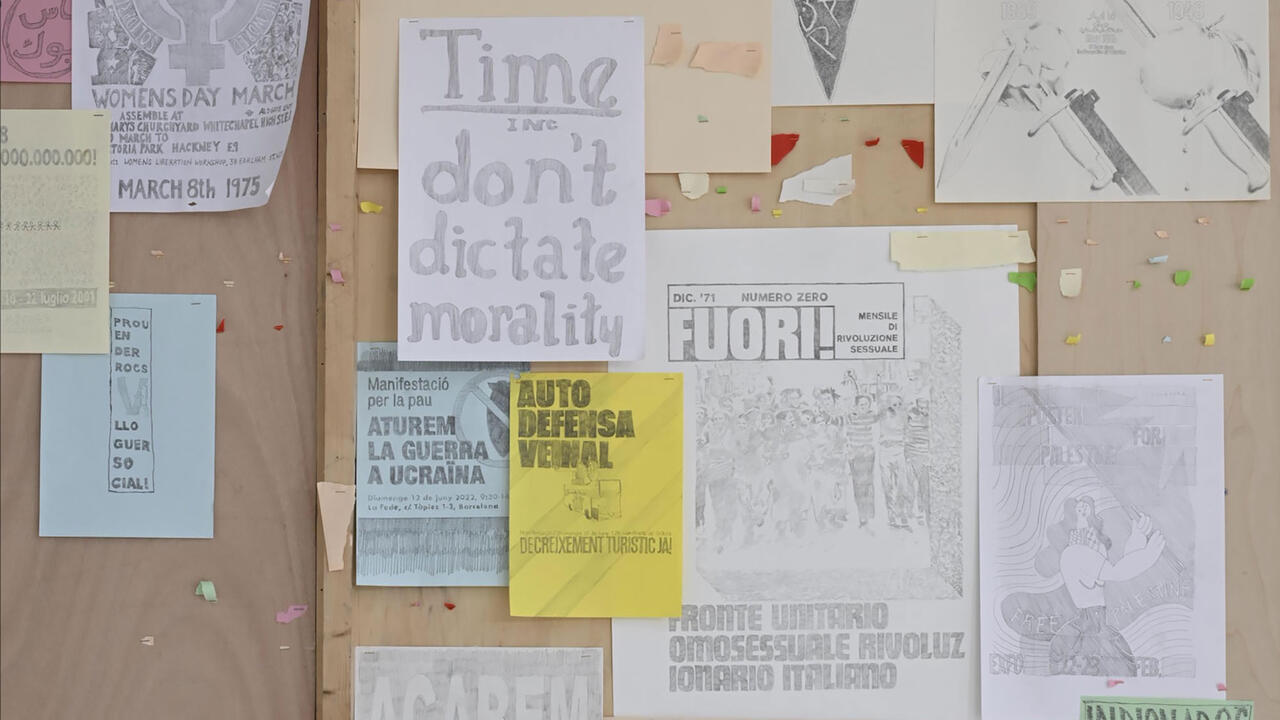What cannot be used is forgotten
CAPC musée d'art contemporain, Bordeaux
CAPC musée d'art contemporain, Bordeaux

‘What cannot be used is forgotten’ proposed a biographical approach to objects and the histories and allegiances they can constitute. With an emphasis on eroding the legacy of colonial-era ethnography and archaeology, the exhibition comprised the contributions of ten artists who emphasize the accrual and dispersal of the objects’ meaning over time. Objects were broken apart, animated, revered, rumoured, memorized, melted or – as in Pauline M’barek’s sculptures mimicking display stands for imagined wooden masks – missing altogether. Sometimes, objects were not comfortably objects at all, but patterns or techniques. Occasionally, they were alibis employed to provoke historical revision and necessitate textual commentary. In Uriel Orlow’s A Very Fine Cast (110 years) (2007), works ingested past traces of such commentary (captions taken from European museums’ descriptions of the Benin Bronzes robbed by the punitive British Benin Expedition of 1897).
It would seem that curator Catalina Lozano’s laudable approach was informed by the metal-casting method that gave its name to Orlow’s companion piece, Lost Wax (2007), in which an initial form is melted away to allow the production of many others. Moreover, as Orlow’s seven-monitor installation documents, lost-wax metal craftsmen in present-day Nigeria incorporate odd bits of metal into their contemporary plaques in the tradition of the looted bronzes. They are alloys, amalgamations with the potential to disrupt the supposed authenticity of something dubiously acquired. Untitled (Bodies in a Pile) (2012) by Mathieu K. Abonnenc enriched these metallurgic associations. Leaning metal bars were recast from copper crosses, a form of currency used until the 1960s in Katanga, a mineral rich province heavily exploited under Belgian colonial rule that now forms part of the Democratic Republic of the Congo. Sven Augustijnen’s oblique L’Histoire Belge (The History of Belgium, 2007) also grapples with Belgium’s grubby colonial past, via photographs depicting, for example, a particular equestrian monument, coin or sword, displayed next to texts that become intentionally mired in detail and aristocratic conspiracy.
Wax also plays a role in Wendelien van Oldenborgh’s compelling two-screen film La Javanaise (2012), in the form of fabric designs now considered typical of West Africa but, in fact, devised by the Dutch company Vlisco in the 1840s based on Javanese resist-dye wax batik cloths. Through the interiors of Amsterdam’s Tropenmuseum (originally founded to display Dutch colonial possessions) the wandering camera follows artist Charl Landvreugd and the striking Sonja Wanda, who models for Vlisco, as they discuss her life story and its entanglement with the intricate weave of exchange, heritage and authenticity represented by Wax Hollandaise fabrics.
Jorge Satorre’s Killing Pots project (2013–14) grew out of research at the Museo Comunitario del Valle de Xico in Mexico City and is supplemented by a series of posters detailing the pre-hispanic objects from its collection, many of which – bowls, figurines – had been in daily use in people’s homes. Satorre addressed the disputed provenance of these objects and the differing values they hold for the community and the archeological authorities by commissioning replicas of several stone objects, including a turtle carving and mortars, then breaking them in two, following the practice of ‘killing’ items that are buried with their dead owners in order to put them out of use.
Given that understanding such projects involves a plunge into contextual information, their accumulation risked overwhelming the audience. Moreover, whether condensed on this page, or in the exhibition’s interpretative texts, writing about research is not necessarily commensurate with writing about art. Counterintuitively, different tacks – such as Beatriz Santiago Muñoz’s melodic video around Haitian Vodou, Nocturne (2015) – didn’t shine as brightly as they might have done. Similarly, Mariana Castillo Deball’s elegant drawings, The Molyneux Problem (2001), engage with an intriguing philosophical puzzle around visual cognition, yet seem part of another conversation.
Sean Lynch’s brilliant A blow-by-blow account of stonecarving in Oxford (2014) dispels any notion that such risks and doubts could not be brushed off with sheer imaginative horsepower and intellectual levity. Comprising a video slideshow, photography and a stone sculpture of a monkey, it traces the work of itinerant Irish carvers John and James O’Shea and their intricate stonework on the facade of the Museum of Natural History in Oxford. Carried by the charismatic slideshow narration, Lynch’s bardic impulse segues from the brothers’ craft to dodos, dinosaurs and fried chicken, musing on the mission of museums and the lucidity of Darwinism in between. One section of the narration offers a tantalizing lens for thinking with the complexity of this exhibition’s object lesson. Evolutionary theory’s revelation for museums is that objects and artworks – like species – ‘are not embodiments of eternal essences’, yet slow accumulations.























